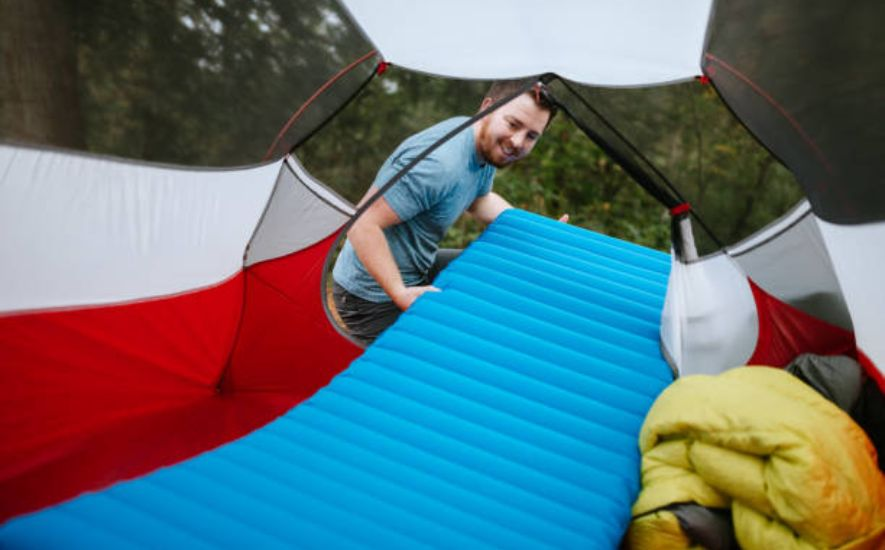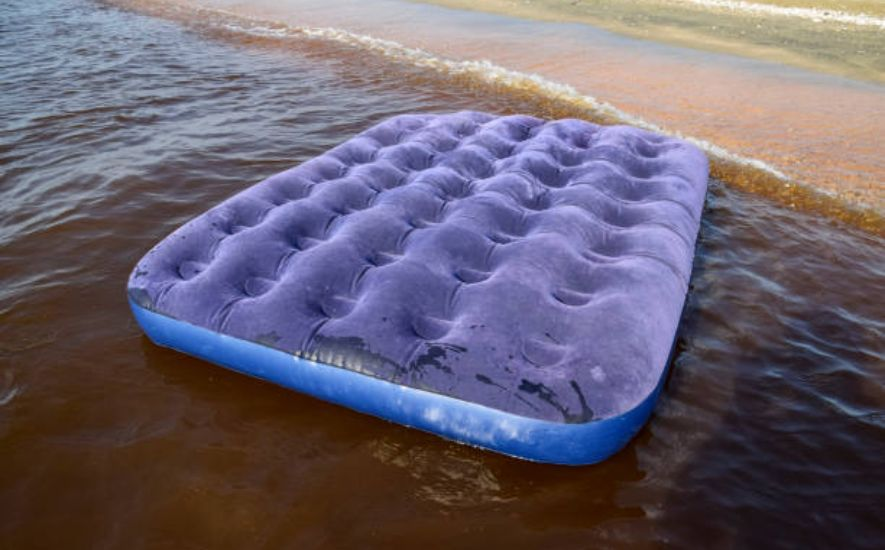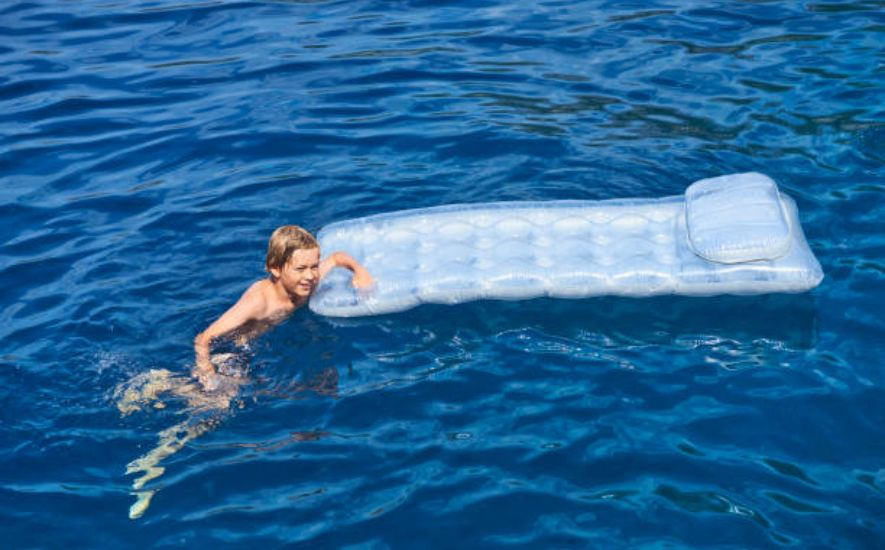Have you ever gone camping and struggled with inflating your mattress manually? Or perhaps you've slept on a thin and uncomfortable mattress that left you tossing and turning all night? If so, then you might be interested in learning about self-inflating mattresses, a modern and convenient solution to traditional camping bedding.

Self-inflating pads or mattresses use advanced technology to provide you with a comfortable and supportive sleeping surface without the hassle of manual inflation.
These mattresses have a special foam core that automatically expands and fills with air when the valve is opened. As the foam expands, it draws in air from the outside and compresses it within the mattress, creating a cushioned and sturdy base for you to sleep on.
The foam inside the mattress is designed to maintain its shape and size, providing consistent comfort and support throughout the night. Most self-inflate mattresses also come with a built-in air pump that allows you to adjust the firmness of the mattress to your desired level.
Whether camping outdoors or hosting guests at home, a self-inflating mattress is a convenient and comfortable sleeping solution that will save you time and effort. So why not give one a try and experience the luxury of a self-inflating mattress for yourself?

Science Behind Self-Inflating Mattresses Working
Have you ever wondered how a small, compact package transforms into a comfortable, cushiony sleeping surface?

Self-inflating pads have revolutionized the camping and backpacking industry, providing campers and hikers with a comfortable and convenient sleeping solution. But have you ever thought about the science behind the self-inflating mattress?
The Principle of Thermal Expansion
Self-inflating mattresses work on the principle of thermal expansion. When you open the valve of a self-inflating mattress, air rushes into the mattress, inflating it to its full size.
The air inside the mattress is trapped between layers of open-cell foam, which has small pockets of air that allow it to expand when the valve is opened.
This open-cell foam has a property known as thermal expansion, which means that it expands when exposed to heat. When the valve of the self-inflating mattress is opened, the air rushes into the mattress, causing the foam to expand and inflate the mattress.
The Role of Atmospheric Pressure
Another important factor contributing to self-inflating mattresses' inflation is atmospheric pressure. The air pressure outside the mattress is greater than the air pressure inside the mattress.
When the valve of the self-inflating mattress is opened, the air rushes into the mattress to equalize the pressure inside and outside the mattress. As the air rushes into the mattress, it causes the foam to expand and inflate the mattress.
The Chemical Reaction
In addition to thermal expansion and atmospheric pressure, the self-inflating mattress also uses a chemical reaction to inflate itself. The foam inside the mattress contains a small amount of polyurethane, which reacts with the moisture in the air to produce carbon dioxide gas.
This gas is trapped inside the mattress and causes it to inflate. The chemical reaction takes some time to complete, so it is important to give the mattress some time to inflate fully after opening the valve.

Benefits of Self-Inflating Mattresses
Good quality sleep is essential for our overall well-being, and the right mattress plays a crucial role in achieving it. A good night's sleep can help reduce stress, improve memory, and boost our immune system.

Traditional mattresses are bulky and require manual inflation, which can be a daunting task, especially after a long day of camping or trekking. Fortunately, technology has come a long way, and self-inflating mattresses have become popular among outdoor enthusiasts.
Convenience
The primary benefit of a self-inflating sleeping pad is its convenience. It eliminates the need for manual inflation, which can be time-consuming and tiring. All you need to do is unroll the mattress, open the valve, and let it inflate itself.
Once inflated, you can adjust the firmness to your liking. This feature is especially useful when you're camping or trekking and you're tired after a long day. You can set up your mattress quickly and enjoy a good night's sleep without any hassle.
Comfort
Self-inflating sleeping pads offer excellent comfort, especially when compared to traditional camping mattresses. They are thicker, and softer, and provide better insulation from the ground. This feature is essential when you're camping in colder regions, and the ground temperature can drop significantly at night.
A good quality self-inflating mattress can provide excellent insulation and keep you warm throughout the night. It also offers better support to your back and neck, which can help reduce aches and pains.
Durability
Self-inflating mattresses are built to last. They are made of high-quality materials that can withstand the wear and tear of outdoor activities. They are also resistant to punctures, which is a common problem with traditional camping mattresses.
This feature is especially useful when you're camping in rugged terrain, and your mattress can come in contact with sharp objects. A good quality self-inflating mattress can last for several years and provide excellent value for money.
Easy to pack and store
Self-inflating mattresses are easy to pack and store. Once deflated, they can be rolled up and packed into a small sleeping bag, which can be easily stored in your backpack. This feature is especially useful when you're trekking or backpacking and you must carry your gear.
Traditional camping mattresses can be bulky and take up a lot of space, which can be a problem when you're traveling light. Self-inflating mattresses are lightweight, compact, and easy to carry, making them an ideal choice for outdoor enthusiasts.

How to Choose the Right Self-Inflating Mattress
Sleeping comfortably while camping or on a backpacking trip is essential to recharge your energy for the next day. However, nothing is worse than waking up with a sore back or feeling restless due to an uncomfortable sleeping surface.

A self-inflating mattress is a great solution to ensure a comfortable and sound sleep. But with so many options available in the market, how do you choose the right one?
Size Matters
When choosing a self-inflating mattress, the first factor to consider is the size. The mattress should be large enough to accommodate your body comfortably.
If it's too small, you may feel cramped, leading to an uncomfortable sleep. However, remember that the larger the mattress, the heavier and bulkier it will be to carry.
Thickness and Comfort
The thickness of the mattress determines how comfortable it will be to sleep on. A thicker mattress provides more cushioning and insulation from the ground, ensuring a comfortable sleep.
However, it will also be bulkier and heavier. So, you need to strike a balance between thickness and weight based on your needs and the nature of your trip.
R-Value
The R-value is a measure of a mattress's insulation capacity. The higher the R-value, the more insulation it will provide, keeping you warm in cold weather.
If you're camping in the winter or at high altitudes, choose a mattress with a high R-value. However, remember that a higher R-value also means a higher price tag.
Material
Self-inflating mattresses are usually made of three materials: foam, air, or a combination of both. Foam mattresses provide good insulation and cushioning but can be heavy and bulky.
Air mattresses are lightweight and packable but offer less insulation and can be uncomfortable to sleep on. Hybrid mattresses combine foam and air to provide a balance of insulation, cushioning, and weight.

Comparing Self-Inflating Mattresses to Other Sleeping Pads
Are you an avid camper or hiker who loves spending time in the great outdoors? If so, you know how important a good night's sleep can be for your overall camping experience.

When it comes to sleeping pads, there are a variety of options to choose from, but self-inflating mattresses have been growing in popularity.
Comfort
One of the biggest advantages of self-inflating mattresses is their comfort level. They are typically thicker than other types of sleeping pads, providing a more cushioned sleeping surface.
Additionally, the foam inside the mattress will conform to your body shape, reducing pressure points and providing a more restful night's sleep.
Convenience
Another benefit of self-inflating mattresses is their convenience. They can be easily inflated by opening the valve and allowing air to flow into the mattress. This eliminates the need for a pump or any other equipment to inflate the pad.
When it's time to pack up, open the valve and roll up the mattress. It will deflate and can be easily packed away in your backpack or camping gear.
Insulation
Self-inflating mattresses also provide insulation from the ground, which can be important in colder weather. The foam inside the mattress traps air and provides a barrier between you and the ground, preventing heat loss and keeping you warmer throughout the night.
Price
Finally, the cost of a self-inflating mattress can vary widely depending on the brand and features. They are generally more expensive than closed-cell foam pads but can be less expensive than most self-inflating pads. It's important to consider your budget and camping needs when choosing a sleeping pad.
Innovations in Self-Inflating Mattress Technology
Sleep is essential for our physical and mental well-being. A good night's sleep is necessary to recharge our bodies, reduce stress, and increase productivity. But, how often have you had to compromise on sleep quality because of an uncomfortable mattress?
Fortunately, technology has come to the rescue with self-inflating mattresses. These innovative products have revolutionized the camping and backpacking industry, making it easier than ever to get a good night's rest outdoors.
The evolution of self-inflating mattress technology
Self-inflating mattresses were first developed in the 1970s by John Burroughs, who was looking for a more comfortable and convenient way to camp. These early versions were heavy, bulky, and not very durable. However, as technology has advanced, so too have self-inflating mattresses.
Today's self-inflating mattresses are made from high-quality materials, such as nylon and polyurethane, that are lightweight and durable. They are also designed to be more compact, making them easy to pack and transport.
The benefits of self-inflating mattresses
One of the main benefits of self-inflating mattresses is their convenience. They are incredibly easy to set up and inflate, requiring only a few breaths or the use of a pump. They are also comfortable and provide excellent support for a good night's sleep.
Self-inflating mattresses are also versatile. They can be used for camping, backpacking, or as a spare bed for guests. They are also perfect for those who suffer from back pain, as they offer excellent support for the spine.
Features to look for when choosing a self-inflating mattress
When choosing a self-inflating mattress, there are several features to consider. The first is the size and weight of the mattress. You want to choose a mattress that is lightweight and easy to transport, but also large enough to provide adequate space for sleeping.
You should also consider the thickness and firmness of the mattress. A thicker mattress will provide more comfort and insulation, while a firmer mattress will provide better support for your back.
Finally, consider the materials used to make the mattress. Look for high-quality materials that are durable and long-lasting.
The future of self-inflating mattress technology
As technology continues to advance, so too will self-inflating mattress technology. We can expect to see even lighter, more compact mattresses that provide even more comfort and support. We may also see new materials being used, such as memory foam, to provide even better support for the spine.
Frequently Asked Questions (FAQs)
A self-inflating mattress is a piece of equipment that can be a lifesaver for outdoor enthusiasts and travelers. These innovative mattresses work by harnessing the power of air to create a comfortable sleeping surface without the need for a pump or electricity. In this FAQ, we'll explore how these marvels of engineering work and answer some of the most common questions about them.
How long does it take for a self inflating mattress to inflate?
The amount of time it takes for a self-inflating mat to inflate can vary depending on the specific model and the conditions in which it is being used. However, most self-inflating mattresses will be fully inflated within 5-10 minutes.
Some models may take longer if they are larger, thicker, or if the air temperature is particularly cold. To speed up the inflation process, it can be helpful to manually inflate the mattress by blowing all the air into it for the first few breaths.
How do you fill a self inflating mattress?
To fill a self-inflating mattress, you first need to unroll it and lay it flat on the ground. Next, you'll need to open the valve and allow the mattress to begin inflating independently.
Some models may require you to manually inflate the mattress for the first few breaths to get the process started. Once the mattress is fully inflated, you can close the valve and adjust the firmness to your desired level by adding or releasing more air as needed.
How does a self-inflating mattress deflate?
To deflate a self-inflating mattress, you'll need to open the air valve and allow the air to escape. Depending on the specific model, you may need to manually roll or fold the mattress to help push the air out.
Once the majority of the air has been released, you can use a compression strap or stuff sack to compress the mattress to a smaller storage size.
Are self inflating mattresses worth it?
Whether or not a self-inflating mattress is worth it depends on your needs and preferences. Some people find self-inflating mattresses more convenient and comfortable than traditional air mattresses or foam pads, especially for camping or other outdoor activities.
They are typically more durable and can provide better insulation from the ground. However, they may be heavier and bulkier to transport than other options, and they can be more expensive.
Ultimately, it's up to you to decide if the benefits of a self-inflating mattress outweigh the drawbacks for your specific situation.
Conclusion
In conclusion, a self-inflating mattress or self inflating camping mat is a fascinating invention that provides a comfortable and convenient solution for camping, backpacking, and outdoor adventures. By utilizing the principles of pressure and airflow control, these mattresses can inflate themselves to the desired level of firmness with minimal effort.
The ingenious design of self-inflating mattresses not only saves time and effort but also ensures a good night's sleep in the great outdoors. Whether you're a seasoned camper or a novice explorer, a self-inflating mattress is a must-have for any outdoor adventure, offering the perfect blend of comfort, convenience, and innovation.











